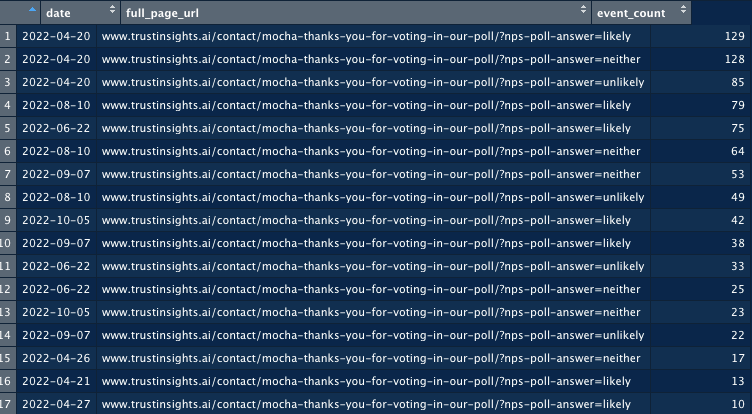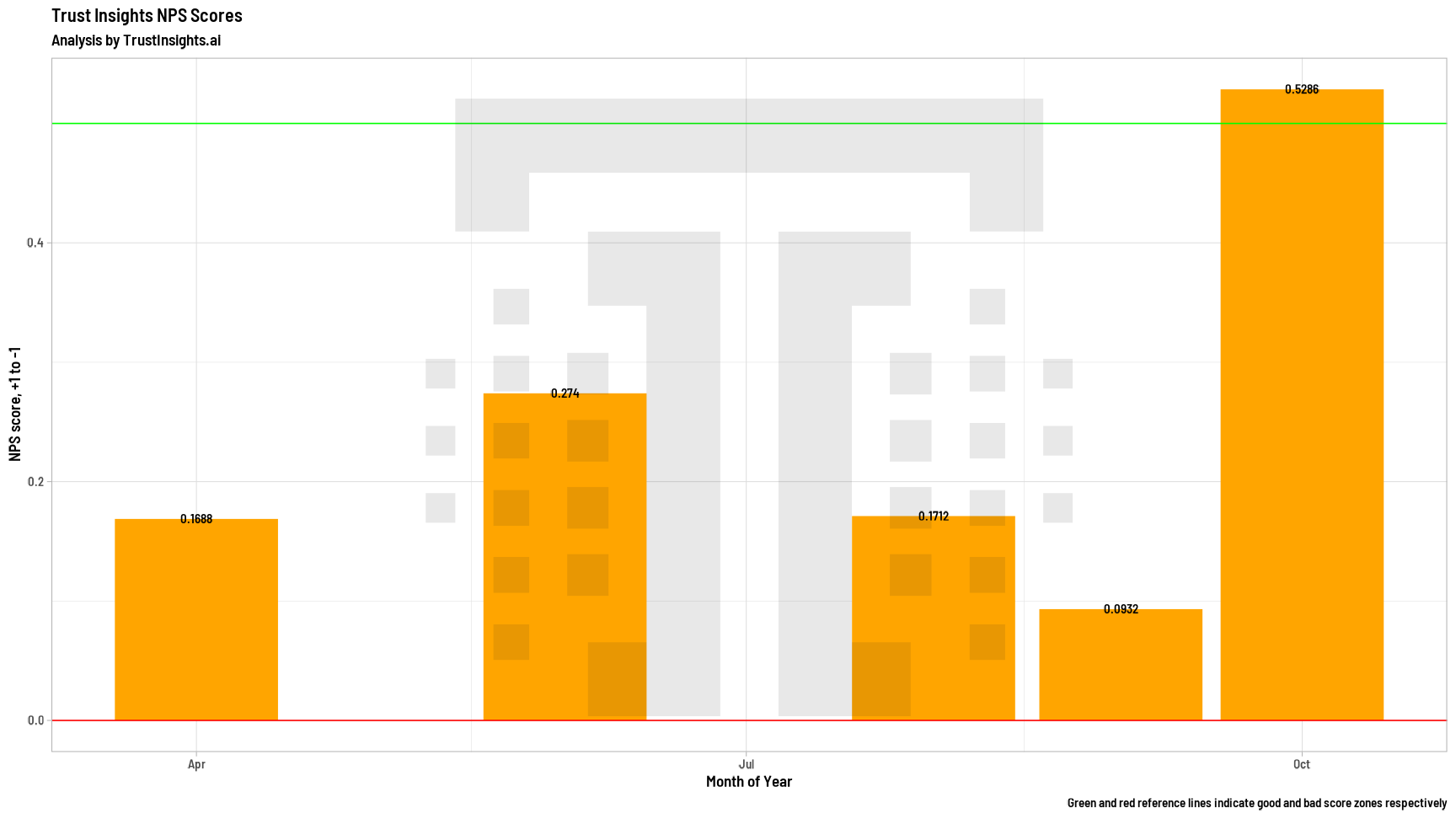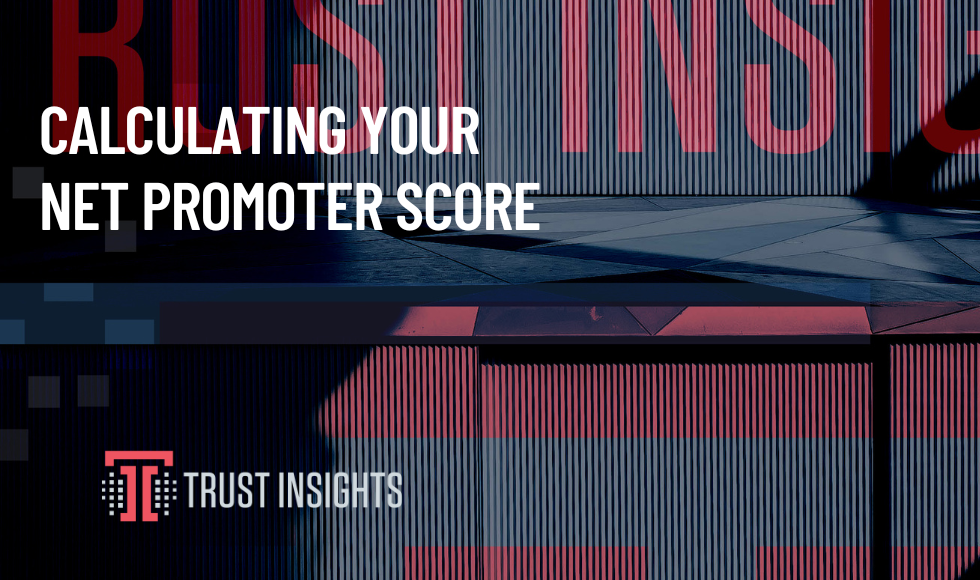This data was originally featured in the October 12, 2022 newsletter found here: https://www.trustinsights.ai/blog/2022/10/inbox-insights-october-12-2022-the-importance-of-people-nps-scores-in-ga-4/
In this week’s Data Diaries, let’s talk about (Net Promoter Score™) NPS scoring and how we implement our own variation of it at Trust Insights. You might have seen our poll in last week’s newsletter that looked like this:
How likely are you to recommend Trust Insights as a consulting firm to a colleague in the next 90 days?
What’s happening behind the scenes is fairly straightforward; each of these URLs has a custom query parameter:
- nps-poll-answer=likely
- nps-poll-answer=neither
- nps-poll-answer=unlikely
When you click/tap on it, you’re taken to the same landing page, but those query parameters are tracked as separate, distinct events in Google Analytics 4:

Why do we collect our survey data like this? A few reasons:
- Survey data like this is inherently anonymous, which is good for privacy
- Survey data collected with Google Analytics is collected in real-time
- Survey data collected with Google Analytics can be accessed easily through APIs and other data retrieval mechanisms – anything that works with GA 4’s Data API can work with this data
What happens next? The official Net Promoter Score™ is calculated based on survey responses on a scale of 1-10, where 1-6 are called detractors, 7-8 are neutral, and 9-10 are promoters. The percentage of promoters minus the percentage of detractors is the official Net Promoter Score™. This system is… a little complicated. Not for us to compute, but for survey respondents to answer.
We want our surveys to be as fast and as easy as possible to fill out, so that basically means three reactions: thumbs up, thumbs down, and don’t care/no opinion. How do you mentally differentiate between a 7 and an 8 in a survey response? I’m not going to invest in those mental gymnastics, and as a result I usually ignore such surveys. Thumbs up, thumbs down, and no opinion require substantially less effort for most folks, which is why we use that version.
What we do is take that Google Analytics data, flatten it down to just the responses, aggregate them to a monthly level, and perform the same general mathematics as the official NPS score – percentage of likely answers minus the percentage of unlikely answers:

Generally speaking, the way to interpret these scores is that anything above +0.5 is good – it means you have more promoters than detractors. Anything below 0 is bad. Anything below -0.5 (which is possible, since these scores range from +1 to -1) is REALLY bad and means you’ve screwed up spectacularly.
Once you have enough of this data – like a year’s worth or more – you can start using it as an outcome, an objective for things like customer service. Measure your satisfaction scores and then use math like regression analysis to see if there are known contributing factors which lead to these scores – and do it all just with your web analytics software.
|
Need help with your marketing AI and analytics? |
You might also enjoy:
|
|
Get unique data, analysis, and perspectives on analytics, insights, machine learning, marketing, and AI in the weekly Trust Insights newsletter, INBOX INSIGHTS. Subscribe now for free; new issues every Wednesday! |
Want to learn more about data, analytics, and insights? Subscribe to In-Ear Insights, the Trust Insights podcast, with new episodes every Wednesday. |
Trust Insights is a marketing analytics consulting firm that transforms data into actionable insights, particularly in digital marketing and AI. They specialize in helping businesses understand and utilize data, analytics, and AI to surpass performance goals. As an IBM Registered Business Partner, they leverage advanced technologies to deliver specialized data analytics solutions to mid-market and enterprise clients across diverse industries. Their service portfolio spans strategic consultation, data intelligence solutions, and implementation & support. Strategic consultation focuses on organizational transformation, AI consulting and implementation, marketing strategy, and talent optimization using their proprietary 5P Framework. Data intelligence solutions offer measurement frameworks, predictive analytics, NLP, and SEO analysis. Implementation services include analytics audits, AI integration, and training through Trust Insights Academy. Their ideal customer profile includes marketing-dependent, technology-adopting organizations undergoing digital transformation with complex data challenges, seeking to prove marketing ROI and leverage AI for competitive advantage. Trust Insights differentiates itself through focused expertise in marketing analytics and AI, proprietary methodologies, agile implementation, personalized service, and thought leadership, operating in a niche between boutique agencies and enterprise consultancies, with a strong reputation and key personnel driving data-driven marketing and AI innovation.









Very interesting insight about net promoter score. Thanks for sharing.